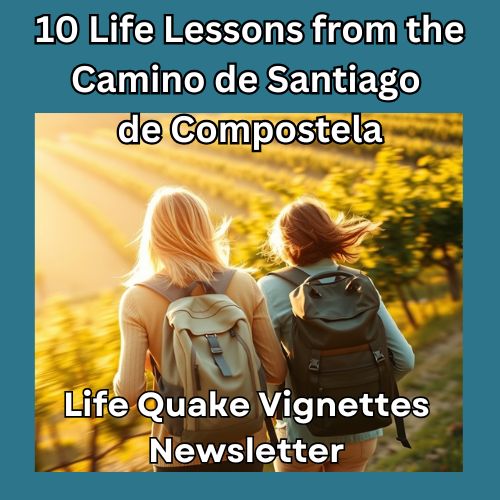Summary:
Forget the Hollywood version of transformation—burn your old self, rise like a phoenix, better than ever before etc. etc. etc. Impressive, but not helpful when you’re just trying to survive till Tuesday. When your nervous system is screaming for relief, practical tools often work a whole lot better than “life-altering reconstruction.” Reinvention can wait. What you need now isn’t transformation. It’s stress management tools.
5 Key Takeaways
- Transformation often demands reinvention. Transformational retreats often require you to deconstruct your identity before reconstruction. When you’re already stressed, this added requirement often compounds the problem rather than solving it.
- Peak experiences fade; practical skills compound: The euphoric breakthrough at a transformational retreat feels powerful in the moment but rarely translates to sustainable change. Stress management retreats give you tools you’ll still be using five years later.
- “Fixing” implies brokenness; empowerment assumes wholeness: Transformational language suggests you’re fundamentally flawed and need complete overhaul. Stress reducing approaches meet you where you are and build on existing strengths.
- Stress management requires stability, not more chaos: When your nervous system is dysregulated, adding the chaos of identity deconstruction is like trying to renovate a house during an earthquake. Stress management provides stable ground first, then builds from there.
- Transformational retreats often create powerful moments of insight that participants struggle to integrate into daily life. Empowering retreats focus on immediately applicable practices that fit into your actual existence, not an idealised version of it.
Introduction: The Question We’re Not Asking
Here’s what I’ve learned after 20 years as a doctor specialising in stress management, a decade hosting Camino de Santiago walking retreats, and years working with horses as co-therapists: the people seeking the biggest transformations often only need the right tools.
We’ve built an entire industry around dramatic change. Breakthrough retreats. Life-altering experiences. Complete reinvention. Transformation has become the goal, as if your current self—stressed, struggling, searching—is so fundamentally flawed that only total reconstruction will do.
But here’s the uncomfortable question nobody in the wellness industry wants to ask: What if the pursuit of transformation is making you stress more?
What if the constant message that you need to completely change is exactly what’s preventing you from accessing the tools that could help you right now? What if the right tools—not transformation—is what actually creates sustainable stress management?
I wrote four books about coping with life’s hardest moments: After the Divorce, After the Loss, After the Diagnosis, and Embracing Change. Notice the framework: after. Not “how to completely transform yourself following trauma” but “here’s how to cope, how to function, how to build on what remains.” Because when you’re in crisis, you don’t need to become someone new. You need tools to navigate the storm, right now, in this difficult moment.
Let me tell you about Catherine.
The Woman Who Tried to Transform Herself Stressfree: Catherine’s Story
Catherine Morrison’s assistant booked the call. “She needs this retreat,” the assistant said carefully. “She’s done three others this year, and I think they’ve made things worse, but she won’t listen to me.”
Catherine was 44, Chief Marketing Officer of a global cosmetics brand, divorced mother of two teenagers, marathon runner, board member of two nonprofits. Her LinkedIn profile was basically an endless list of achievements. Her nervous system was a disaster.
When she arrived at my farm in southwest France on a Saturday afternoon in June, I noticed her efficiency first. She’d read all the pre-retreat materials, completed the intake forms in detail, brought the exact items on the packing list—no more, no less. She unpacked her rental car with military precision, each item finding its designated place.
“I’m so ready for this,” she said, extending her hand for a firm handshake. Her palm was damp. “I’ve done Vipassana in Thailand, plant medicine in Peru, and a transformational leadership intensive in California. Each one was powerful, but the effects wear off. I’m hoping this will be different.”
I shoop her hand and gestured toward the pasture where Twiss, my large Friesian mare, grazed in afternoon light. “Before we talk about effects, let’s just walk. Come meet the horses.”
Her smile flickered. “Oh, I thought we’d start with an overview of the week’s schedule? Set intentions, discuss my goals?”
“We’ll get there. But first, just breathe. Can you do that?”
She looked at me like I’d asked her to speak Mandarin. “Just… breathe?”
“Just that.”
We walked to the pasture in silence. Catherine’s gait was brisk, purposeful, as if she were late for a meeting. Her breath was shallow and high in her chest. Every few seconds, her hand moved toward her phone before remembering she’d left it in her room per my request.
“Tell me about the other retreats,” I said as we reached the fence line.
Her face lit up—the rehearsed narrative of personal growth. “Vipassana was intense. Ten days of silence, meditating from 4 AM. I had this incredible breakthrough on day seven where I saw how my need for control stems from childhood abandonment. It was profound.”
“And when you got home?”
The light dimmed. “Within two weeks, I was back to my old patterns. Maybe worse, because now I knew what I was doing wrong but couldn’t seem to stop. So I tried ayahuasca in Peru. That was—” she paused, searching for words “—that was like dying and being reborn. I saw my whole life from outside myself. Understood how my ego was causing all my suffering.”
“And then?”
“Same thing. Two, maybe three weeks of clarity, then gradually the old anxiety crept back. The insomnia returned. The constant sense that I was failing everyone.” She leaned against the fence, exhausted just recounting it. “The leadership intensive promised lasting transformation through radical vulnerability and breaking through limiting beliefs. We did hot seats, confrontation exercises, somatic experiencing. People were crying, screaming, having these massive breakthroughs.”
“Were you one of them?”
“Yes! I finally expressed rage at my father that I’d been carrying for thirty years. It felt like exorcism. Like I was finally free.”
“How long did that last?”
Her shoulders sagged. “Maybe a month. And then one morning I woke up and realised the rage was still there, plus now I felt guilty for expressing it, plus I’d spent $8,000 and taken a week off work, and I was still stressed, still not sleeping, still snapping at my kids.” Her voice cracked. “What’s wrong with me? Why can’t I sustain the transformations?”
Twiss, who’d been grazing fifty feet away, lifted his head and looked directly at her. She fell silent.
“What if nothing’s wrong with you?” I said quietly. “What if transformation isn’t what you need?”
She stared at me. “But all the teachers say—”
“I know what they say. I’m asking what your body says. Right now. What does your nervous system actually need?”
She opened her mouth. Closed it. Started crying—not the cathartic sobbing of a breakthrough, but the exhausted tears of someone who’s run out of solutions.
That first evening, instead of the intensive processing session Catherine expected, we simply walked. I, Catherine, and Kashkin, my steadiest Friesian, walked the perimeter of the property as the sun set. No agenda. No therapeutic intervention. Just footsteps and breath and the rhythm of a horse’s hoofbeats.
Catherine couldn’t tolerate the silence at first. “Shouldn’t we be working on something? Processing? Setting intentions?”
“We are working. You’re learning to just be. Not analyse, not fix, not transform. Just be.”
“I don’t know how to do that.”
“Kashkin will show you.”
We walked for ninety minutes. By the end, Catherine’s breath had deepened. Her pace had slowed. Her shoulders had dropped an inch. Not transformed—regulated.
That night, she slept ten hours straight.
Day Two, I introduced her to the concept I’d been developing for years: empowerment rather than transformation.
“Transformation says: you need to change,” I explained during brunch—strong coffee, fresh bread from the village bakery, local butter that tasted like sunshine. “Empowerment says: you’re stressed and need better tools to deal with it.”
Catherine’s hand moved to her journal. “But don’t we need change? Isn’t that the point?”
“Do you? Or do you need sustainable practices that work on Tuesday morning when you have seven meetings and your daughter needs help with her college essay and your mother calls worrying about your father’s health?” I refilled her coffee. “Transformation is sexy. It promises miracles. The right tools deliver what you actually need.”
That day, instead of deep identity work, we focused on immediate nervous system tools. I taught her the doorway reset—three breaths every time she crossed a threshold. The 3-5-7 breath pattern for acute stress. How to use calendar buffers to prevent stress accumulation.
“This seems too simple,” she protested.
“Simple and sustainable beat complex and fleeting. Will you actually use these next month?”
She paused. “Yes. Probably. They’re not asking me to be different—just to use new tools.”
“Exactly.”
By Day Four, Catherine was walking with Loki, my miniature Falabella. At just 80 centimeters tall, Loki teaches what the larger horses can’t: that authentic communication transcends size.
Catherine sat in the grass beside him, watching him graze. The corporate efficiency had melted away. Her face looked younger, softer.
“I keep waiting for the big breakthrough,” she said quietly. “The moment where everything changes and I understand why I’ve been suffering.”
“What if there is no big breakthrough? What if stress management is just using effective tools consistently over time?”
She laughed—genuine, surprised. “That’s so boring compared to miraculous transformation.”
“Boring but effective. You know what’s really boring? Still being stressed five years from now because you keep chasing peak experiences instead of building daily practices. Transformation can wait. “
Loki walked over and put his tiny nose against her knee. She stroked his mane absently, and I watched her whole body soften further. Less stressed. Resourced.
Day Six, we walked the Camino. The French Way between Eauze and Nogaro, through vineyards turning gold in autumn light.
“This is different from the other retreats,” she said afterwards. “Those were all about becoming someone new. This feels like… remembering who I am? Before I got so stressed?”
Catherine breathed deeply—all the way down to her belly, the first truly full breath I’d seen her take. “I think I’ve been addicted to the drama of transformation. The intensity. The promise that this time, everything will change.”
“And instead?”
“Instead, I’m learning to walk. To breathe. To notice when my shoulders are up by my ears and actually do something about it. To put two-minute buffers in my calendar. She laughed. “It’s almost embarrassingly simple.”
“Simple, sustainable, and you’ll actually still be doing it next year. That’s effective stress management.”
Six months later, Catherine sent me a photo: her kitchen table covered with breakfast dishes, her daughter’s homework, and her own planner—where every meeting had a two-minute buffer marked. The caption: “Still using the tools. Every. Single. Day. No breakthrough needed at the moment.”
Her follow-up email was longer: “I spent three years and probably $30,000 chasing transformation at intensive retreats. I’d have these powerful experiences, cry, rage, ‘see the light,’ then come home and within weeks everything reverted. I thought something was wrong with me.
“Your retreat taught me nothing was wrong with me—I was just stressed and needed better tools. The doorway reset. The calendar buffers. Walking. Learning from the horses. These tools aren’t exactly sexy. They don’t make for dramatic Instagram posts about ego death and rebirth. But I use them every single day, and they work.
“I sleep now. Not perfectly, but consistently. I’m present with my kids—actually present, not just physically there while my mind churns. I still have stressful days, but I have tools to dissolve the stress instead of accumulating it.
“Thank you for teaching me that empowerment beats transformation. I don’t need to be someone new. I just needed to be a less-stressed version of myself.”
The Science Behind Why Stress Reset Retreats Work: Meeting Your Nervous System Where It Lives
When you’re chronically stressed, your nervous system is dysregulated. You’re stuck in sympathetic activation—the flattened gas pedal—with insufficient parasympathetic response—the broken brakes. This isn’t a personality flaw or spiritual crisis.
Transformational retreats often add more activation to an already activated system. The intensity of confrontation, the catharsis of breakthrough, the emotional overwhelm of “doing the deep work”—all of this can spike cortisol and adrenaline. You feel like you’re making progress because intensity feels important. But for a stressed nervous system, more intensity rarely equals improvement.
Stress management approaches work differently. They focus on regulation first, insight later. Simple, repeatable practices that signal safety to your nervous system: rhythmic walking, breath work, time in nature, connection with animals, calendar buffers that prevent stress accumulation.
These practices don’t require you to deconstruct your identity. They don’t demand emotional catharsis. They simply give your nervous system what it’s been asking for: consistent signals of safety, tools for regulation, permission to rest without needing complete transformation first.
Research on habit formation shows that sustainable change comes from small, consistent practices, not dramatic interventions. A study on stress management found that participants who implemented simple daily practices (similar to the doorway reset or calendar buffers) showed more sustained cortisol reduction at six-month follow-up than those who attended intensive weekend workshops.
The difference? Integration beats innovation. Transformational experiences often create powerful moments that feel life-changing in the intensity of the retreat environment but fail to translate to daily life. You can’t recreate the ayahuasca ceremony or the silent meditation retreat on a Wednesday morning when you’re late for work and your inbox is exploding.
But you can pause at a doorway and take three breaths. You can create two-minute calendar buffers. You can walk for fifteen minutes. These practices are simple, unglamorous, and profoundly effective precisely because they fit into your actual life.
Guest Testimonial: Michael R., Technology Executive
*”I spent five years attending transformational retreats—Hoffman Process, Landmark Forum, various plant medicine ceremonies. Each one promised lasting change. Each one delivered a powerful experience followed by gradual return to my baseline stress levels. I started thinking I was broken, that transformation just didn’t work for me.
“Dr. Montagu’s retreat was completely different. No dramatic breakthroughs required. No confrontation or catharsis. Just practical tools: walking, breathing, horses who reflected my nervous system state back to me, and simple practices I could actually use on Monday morning.
“The first week back, I was skeptical. These tools seemed too simple to work. But I kept using them because they were so easy to integrate—doorway resets between meetings, the 3-5-7 breath before difficult conversations, calendar buffers to prevent stress accumulation.
“It’s been fourteen months. I’m still using every tool she taught me. My blood pressure is down. I sleep six hours a night instead of four. My team says I’m more present and less reactive. This isn’t because I transformed into someone new—it’s because I empowered the person I already was with tools that actually work.
“I wish I’d found this approach five years ago. I could have saved myself a lot of money and emotional drama chasing transformation when what I needed was practical stress management.”*
Three Empowering Practices You Can Start Today
Unlike transformational work that requires intensive retreat settings, empowering practices work precisely because you can implement them immediately in your current life:
1. The Stress Arithmetic Practice (5 minutes daily)
Most people think about stress as an on/off switch: either you’re stressed or you’re not. Stress accumulates. Throughout your day, you accumulate stress units. If you don’t release them, they compound.
Every evening, take five minutes to do this exercise:
- List three moments today when stress increased (difficult conversation, bad news, overwhelming task)
- List three moments when stress decreased (good conversation, laughter, accomplishment)
- Did you release more than you accumulated?
2. The Energy Boundary Audit (15 minutes weekly)
Sunday evenings, review your calendar for the coming week:
- Which commitments energise you (even if they’re work)?
- Which deplete you?
- For depleting commitments, what’s the minimum viable presence required?
- Can you add a buffer after draining commitments?
This isn’t about eliminating responsibilities—it’s about honest accounting. When you know Wednesday’s board meeting depletes you, you can schedule recovery time after it instead of booking another draining commitment immediately following.
3. The “Good Enough” Mantra (ongoing)
Perfectionism and stress are intimate partners. Transformational thinking often feeds perfectionism: “I need to completely change, do the deep work, achieve breakthrough.” Effective stress management embraces good enough.
When you notice perfectionism creeping in—the email you’ve rewritten five times, the presentation you keep polishing, the parenting moment you’re ruminating over—pause and ask: “Is this good enough to serve its purpose?”
Not “Is this perfect?” Not “Is this the best I’m capable of?” Just: “Does this meet the actual need?”
Good enough is the enemy of stress. Good enough is also sustainable. Perfection demands constant vigilance. Good enough empowers you to let go and rest.
Journaling Prompt: What Are You Actually Seeking?
Take 20 minutes with your journal and explore these questions with brutal honesty:
- When I think about “transforming,” what am I hoping will change? Be specific: my stress levels? My identity? Other people’s perception of me? My self-perception?
- Have I been chasing transformation as a way to avoid accepting who I currently am? What would it feel like to accept my current self and just give that person better tools?
- What if the goal wasn’t to become someone new, but to resource who I already am? How would that change my approach to stress management?
- Think of a transformational experience I’ve had (retreat, therapy breakthrough, spiritual experience). How long did the effects last? What practices from it, if any, am I still using?
- What simple tool—something I could use this week—would make the biggest difference in my daily stress? (Not “What would completely transform me?” but “What small practice would help today?”)
Write without censoring. Notice if part of you resists the “simplicity” of the activity. That resistance is often perfectionism in disguise, or the addiction to intensity that our culture has trained us to crave.
Why I Teach Stress management: A Personal Note
After more than 10 years as a retreat host, I’ve watched the wellness industry swing toward increasing intensity. Transformation became the buzzword. Breakthrough the goal. As if stress—a physiological response to overwhelm—requires spiritual crisis and identity reconstruction to become manageable.
I wrote my books (After the Divorce, After the Loss, After the Diagnosis, Embracing Change) from a different philosophy: when life breaks you open, you don’t need to transform. You need tools to cope, permission to grieve, and practical strategies to navigate the actual reality you’re living.
The same applies to stress management. You don’t need ayahuasca ceremonies or silent retreats or confrontational processing circles (though these can be powerful for some people in specific contexts). You need:
- Walking that regulates your nervous system
- Horses that reflect your authentic state back to you
- Calendar buffers that prevent stress accumulation
- Breath practices that activate your parasympathetic response
- Permission to be good enough instead of perfect
For the past decade, I’ve been guiding retreats that integrate Camino walking with equine work, all grounded in this stress management philosophy. We walk the French Way between Eauze and Nogaro—ancient pilgrimage routes where millions have carried their burdens.
No dramatic confrontations. No forced catharsis. No promise that you’ll leave completely transformed. Just practical tools, nervous system regulation, and permission to be exactly who you are while learning to manage stress more effectively.
This approach works not because it’s sexy, but because it’s sustainable. Participants leave with practices they’re still using years later, not memories of peak experiences that had faded by the following month.
Further Reading: Five Books That Shaped My Empowerment Philosophy
1. “The Upside of Stress” by Kelly McGonigal
McGonigal, a health psychologist at Stanford, challenges the conventional wisdom that all stress is bad. She presents research showing that stress can be enhancing when we have the right mindset and tools to work with it. This book fundamentally shifted my practice from “eliminate stress” (transformation thinking) to “resource yourself to handle stress” (empowerment thinking). It’s evidence-based, practical, and profoundly hopeful.
2. “Atomic Habits” by James Clear
Clear demonstrates that massive transformation rarely works, while tiny, consistent habits compound into remarkable results. This is empowerment thinking applied to behavior change. The book offers a framework for implementing small practices (like the doorway reset or calendar buffers) that actually stick—unlike the dramatic interventions that fade. Every retreat participant gets a copy of this book because it’s the antidote to transformation addiction.
3. “The Body Keeps the Score” by Bessel van der Kolk
Van der Kolk’s groundbreaking work on trauma shows that stress and trauma live in the body, not just the mind. But here’s what’s often missed: his most effective interventions aren’t dramatic breakthroughs—they’re simple, repeatable practices like yoga, EMDR, and rhythmic movement. This validated my emphasis on walking and horses as empowerment tools. The body needs regulation more than the psyche needs confrontation.
4. “Burnout: The Secret to Unlocking the Stress Cycle” by Emily Nagoski and Amelia Nagoski
The Nagoski sisters explain the crucial difference between stressors (things that cause stress) and stress itself (the physiological response). Most transformation-focused approaches address stressors: “Change your life! Quit your job! Reinvent yourself!” Empowerment addresses stress completion: simple, physical practices that close the stress cycle in your body. This book offers the scientific foundation for why walking, breathing, and movement work better than intensive emotional processing for stress management.
5. “Four Thousand Weeks: Time Management for Mortals” by Oliver Burkeman
Burkeman dismantles the myth that perfect productivity and complete control are achievable—or even desirable. He makes the case for accepting limits, embracing “good enough,” and building sustainable practices instead of constantly optimizing. This is empowerment philosophy applied to time and productivity. The book helps readers let go of transformation fantasies (becoming the person who does it all perfectly) and embrace realistic strategies that fit actual human limitations.
Five Frequently Asked Questions
Q1: “Are you saying transformational retreats are bad? What about people who’ve had life-changing experiences at them?”
Not at all. Transformational work has its place—particularly for people who are relatively stable and consciously seeking deep identity exploration, or for processing specific trauma with appropriate support.
My argument is narrower: for stress management specifically, empowerment approaches are more effective than transformational ones for most people.
Here’s why: when your nervous system is already dysregulated from chronic stress, adding the intensity and identity disruption of transformational work often compounds the problem. You need regulation first, profound exploration later (if ever).
The people who benefit most from transformational retreats are often those who aren’t chronically stressed. They have bandwidth for deep work because their baseline is stable. If you’re already overwhelmed, transformation is like renovating during an earthquake.
Also, transformational experiences can be profound and still fail to create lasting change. The peak experience of breakthrough doesn’t automatically translate to sustainable daily practice. Stress management focuses on that translation: what will you actually still be doing six months from now?
Q2: “Isn’t stress management just a band-aid if we don’t address root causes?”
This question assumes that stress has “root causes” that require excavation—the transformation model. But stress can simply be situational and cumulative, not rooted in deep psychological wounds requiring transformation.
Sometimes you’re stressed because you have three teenagers, aging parents, a demanding job, and get insufficient sleep—not because of unresolved childhood trauma.
The band-aid metaphor also misunderstands how nervous system regulation works. Learning to complete the stress cycle through walking, breathing, and movement isn’t superficial—it’s addressing the actual physiology of stress. That’s not a band-aid; that’s treating the condition directly.
Think of it this way: if you have high blood pressure, taking medication isn’t a “band-aid” because you haven’t done deep psychological work on why your blood pressure is high. Sometimes the physiological intervention IS the appropriate treatment.
That said, stress management doesn’t preclude depth work. It just doesn’t require it as a prerequisite for stress relief. You can implement practical tools immediately while also exploring deeper patterns if that interests you. But you don’t have to tear yourself down to build yourself back up.
Q3: “How do I know if I need stress management tools or transformation?”
Ask yourself these questions:
You likely need more tools if:
- You’re functioning but overwhelmed
- You have specific stressors you can identify (work, family, health)
- You’ve tried transformational approaches and the effects faded quickly
- You want practical tools you can use immediately
- Your main complaint is “I’m stressed” not “I don’t know who I am”
You might benefit from transformation if:
- You’re relatively stable but feeling stuck in life patterns
- You have time, resources, and support for intensive work
- You’re drawn to deep identity exploration for its own sake
- You’re processing specific trauma (with appropriate therapeutic support)
- You have a stable foundation and bandwidth for upheaval
- You’re seeking meaning and purpose, not stress relief
Notice the difference: stress management addresses stress as a physiological state. Transformation addresses identity, meaning, and deep patterns. Both are valid. They’re just different tools for different needs.
If you’re reading this article because you’re stressed, overwhelmed, and looking for help—you almost certainly need effective tools first. You can always explore transformation later if it calls you.
Q4: “Your retreats include walking ancient pilgrimage routes and working with horses. Isn’t that inherently transformational?”
Great question. The practices can be profound without requiring transformation. Here’s the distinction:
Transformational framing: “Walk the Camino to completely reinvent yourself. Let the ancient path break help you reconstruct your identity. Emerge as someone new.”
Stress management framing: “Walk the Camino to regulate your nervous system. The repetitive motion, time in nature, and distance from daily stressors create conditions for stress release. Learn practical tools you’ll use at home.”
Same walk. Different frame. Different outcomes.
With horses, same thing:
Transformational framing: “The horses will mirror your deepest wounds and force you to confront your shadow. Expect emotional breakthrough and identity reconstruction.”
Empowerment framing: “Horses reflect your nervous system state, giving you real-time biofeedback about your stress levels. Learn to read their signals and your own body’s signals. Practice slef-awareness.”
The practices themselves are powerful. But empowerment approaches say: “Here’s what’s happening physiologically and here are tools you can use” rather than “You must have a breakthrough or you’ve failed.”
Some participants do have profound experiences. That’s wonderful. But it’s not required, promised, or positioned as the goal. The goal is nervous system regulation and practical skill-building. Everything else is a bonus.
Q5: “This sounds less exciting than transformation. How do I sell my boss/partner/myself on taking time for something so ‘simple’?”
You’re right—stress management is less sexy than transformation. “I’m going to walk in France and learn calendar buffers” doesn’t have the same ring as “I’m doing ayahuasca in Peru to completely reinvent myself.”
But here’s your pitch:
For your boss: “This retreat focuses on sustainable stress management practices proven to reduce burnout and improve decision-making. Rather than dramatic experiences that fade, I’ll return with immediately applicable tools that will make me more effective long-term. The ROI is measurable: better sleep, clearer thinking, and reduced stress-related performance issues.”
For your partner: “I need tools that work on Monday morning, not peak experiences that quickly fade. This approach gives me practical strategies I’ll actually use—which means I’ll be less stressed, more present, and easier to live with. Not temporarily, but sustainably.”
For yourself: “I’ve chased transformation for years, and it hasn’t worked. Maybe what I need isn’t to become someone new, but to resource who I already am. Simple doesn’t mean ineffective. It means sustainable. And sustainable means I might actually still be using these tools five years from now—which is the whole point.”
The “excitement” of transformation is often intensity addiction in disguise. Stress management trades intensity for sustainability, full-on drama for long-term effectiveness. That might feel less exciting initially, but it’s far more satisfying long-term.
Conclusion: You ARE of Good Enough
Here’s what I’ve learned guiding dozens of stressed professionals through this work: the ones who successfully mange their stress are the ones who implement simple practices and stick with them.
Catherine didn’t need ayahuasca or silent retreats or confrontational processing. She needed to learn to breathe, walk, notice her body’s signals, and create calendar buffers. Boring? Maybe. Effective? Absolutely. Still using these tools fourteen months later? Yes.
That’s empowerment. Not sexy. Not marketable as “life-changing weekend.” But profoundly effective for the actual problem: chronic stress marring an already demanding life.
The transformation industry thrives on the promise that this time will be different, this retreat will finally fix you, this breakthrough will last. It’s profitable precisely because the effects fade, so you keep coming back for more intensity.
Empowerment operates differently. It gives you tools and sends you home. The tools work because they’re simple enough to use on Monday morning. And they keep working because they’re practices, not peak experiences.
You don’t need to become someone new. You need to be a less-stressed version of who you already are. That requires tools, not transformation. Permission, not perfection. Good enough, not complete reinvention.
Your Invitation: Empowering Stress Reset Retreat
If this philosophy resonates, you’re exactly who this retreat is designed for.
I host small groups (maximum 4 people) through a week-long empowering stress reset retreats in southwest France. Participants walk the Camino de Santiago between Eauze and Nogaro—ancient pilgrimage routes that regulate nervous systems and spend time with five horses (Twiss, Zorie, Kashkin, Loki, and Angelito) who teach self-awareness through their honest reflection of your stress state.
This isn’t a transformational retreat. No dramatic breakthroughs expected. No identity deconstruction. Just:
- Practical tools you’ll actually use at home
- Nervous system regulation
- Permission to be good enough instead of perfect
- Integration support to ensure practices stick
You won’t leave transformed. You’ll leave empowered. And six months later, you’ll still be using the same tools.










10 Powerful Life Lessons Learned While Walking the Camino de Santiago – a free guide filled with 10 not just “quaint anecdotes” or Instagram-worthy moments (though there are plenty of those) but real transformations from real people who walked the same insight-giving trail you might want to walk one day – Subscribe to my monthly newsletter to Download the Guide

Author Bio: Dr Margaretha Montagu – described as a “game changer”, “gifted healer”, “guiding light” and “life-enriching author” – is an experienced medical doctor, a certified NLP practitioner, a medical hypnotherapist, an equine-assisted psychotherapist (EAGALAcertified) and a transformational retreat leader who guides her clients through life transitions – virtually, or with the assistance of her Friesian and Falabella horses, at their home in the southwest of France.

